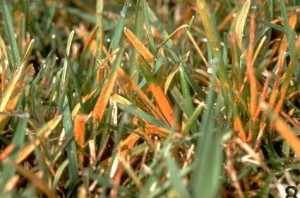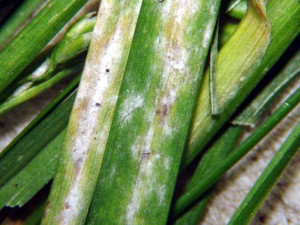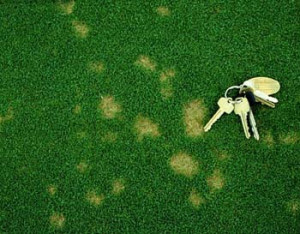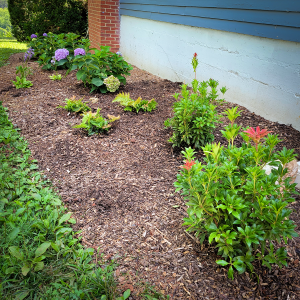Prevent Summer Lawn Diseases
All lawn diseases have their peak seasons, and some in particular are more prone to show during the summer months. Here are three to look for as the weather warms up.

1 Lawn Rust
Lawn rust typically occurs during the summer and early fall months and is caused by a lack of nitrogen in the soil.
How can I identify it?
Look for an overall lawn appearance of yellow, brown, or red. Examine your grass carefully and pick-up a few blades. The spore residue from rust has a tendency to rub off when touched. You may even be tracking the dust into the house.
What causes it?
Lawn rust is the result of inadequate nitrogen and moisture in the soil. Most likely, you haven’t been watering deeply or frequently enough, or you might be cutting your grass too short. Heavy rainfall and sudden changes in humidity can also contribute lower nitrogen levels. And lawn rust is easily spread by people, lawn equipment, wind and rain.
How to solve Lawn Rust?
Don’t mow as often, and adjust the blade height of your lawn mower to the highest possible setting. Never trim off more than one-third of the grass length when mowing. Water your lawn with about an inch of water per week and apply a low-nitrogen fertilizer to your lawn. Normally, rust will fade away by early fall. Most cases will not need the application of any type of fungicide for control or prevention.
Photo credit: University of Minnesota Extension

2. Powdery Mildew
Powdery mildew occurs in shady spots on the landscaping. The issue is more predominant in northern states in the United States and occurs from spring until early fall. While it can be a huge nuisance, the good news is that it is also fairly easy to recognize and to treat once discovered.
You’ll be able to spot powdery mildew in the spring, after the disease survives the winter and spreads through spores at the beginning of the spring season. Identify powdery mildew by looking at the texture of leaves on your lawn. The disease shows itself by creating a felt-like surface on leaves. Powdery mildew gets its name from the gray white dust that forms on the leaf’s surface.
The problem spreads the most in shady areas (which most often are less maintained than other areas of the lawn). It most commonly occurs in bentgrass, Bermuda grass, fine fescue, Kentucky bluegrass and ryegrass. The disease thrives on low sunlight and cooler temperatures, making shady areas the prime location for damage.
How to solve Powdery Mildew? If your lawn contains any cool and shady areas, try to bring in more sunlight. Prune your trees to minimize their coverage of the grass. Use a deep watering plan to ensure that the soil has adequate moisture. In this case, deep watering is more effective than frequent shallow watering. Unfortunately, in some cases, chemical control techniques are necessary to eliminate the problem and prevent it from returning.

3. Dollar Spot
Dollar spot is caused by Sclerotinia homoeocarpa, a fungal pathogen. It does not affect the roots or crown of the grass in your lawn, but it can cause unsightly brown spots on the leaf tissues of the grass, negatively affecting turf vigor and appearance. Dollar spot typically shows up in late spring and early summer.
If you think you may have dollar spot, look for outbreaks of round, tan-colored spots in clusters. These spots can be up to 1 inch in diameter. Look at individual leaves of grass. If you have Dollar Spot disease on your lawn, you will notice lesions on the blades that appear straw-colored in the middle, with red-brown outlines around each lesion.
Dollar Spot disease is often caused by a lack of nitrogen in the soil where grass has been planted. Normally, depletion of nitrogen occurs in late spring or early summer, which helps the disease spread faster. Mycelial, the pathogen that causes this disease in part, also becomes active in the springtime. Extended dew periods of around eight hours or more and temperatures between 55 and 80 degrees Fahrenheit help mycelial grow and become more active. The disease can also be spread by the use of infected blades during mowing, core aeration, or other lawn care operations.
How to solve Dollar Spot? There are quite a few options for control of Dollar Spot disease. You should begin by planting cultivars of grass that are less susceptible to the disease. To help control the disease, switch irrigation to a nighttime and early morning schedule so as not to contribute to longer dew periods. Also, be sure to keep your soil rich in nitrogen by applying fertilizer mid-summer. And as usual, keep your grass trimmed to a height of 2 to 3 inches. Fungicides may also be applied to the lawn if the above treatment methods don’t work, if you have an especially severe outbreak of the disease on your lawn, or if you need quick results.
If you see any of these problems in your lawn Dos Amigos can help. Dos Amigos Landscaping and Lawn Care Services helps prevent these unsightly lawn diseases by using proper mowing techniques, pruning trees and maintaining proper nitrogen levels in your lawn. Call us today to find out how Dos Amigos can can give you a healthy green lawn. Call: (434) 465-0075
Written by Phillip Brown. Reprinted from Total Landscape Care


